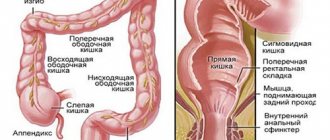Dysbacteriosis is common in newborns
Dysbacteriosis or dysbiosis is a pathology characterized by an imbalance of intestinal bacterial colonies. This disease is not in the modern edition of the ICD. Dysbiosis is often classified under K63, that is, other intestinal diseases.
The problem of disease classification is associated with the complexity of diagnosis. However, in Western medicine there is a similar disease called colon bacterial overgrowth syndrome.
The human intestinal tract is a habitat for many beneficial, harmful and neutral bacteria. Microorganisms inhabit primarily the large intestine, but some bacteria are also found in the small intestine.
The natural bacterial colonies of the intestines are called the microflora or microbiome of the digestive tract. Beneficial bacteria support immune function, help absorb vitamins and other beneficial substances, while harmful bacteria can cause various diseases. With dysbacteriosis, harmful microorganisms predominate in the human intestine.
Dysbacteriosis is a common diagnosis, but doctors are often criticized for the lack of evidence for the existence of such a pathology. Most standard tests cannot accurately confirm the presence of such a pathology, so many gastroenterologists focus only on the patient’s complaints.
Pharmaceutical companies use this uncertainty as fertile ground for speculation, creating drugs with unproven effectiveness.
Modern ICD reference books and children's classification
Dysbacteriosis - imbalance of intestinal microflora
The International Classification of Diseases is recognized in most countries of the world. In the Russian Federation, doctors make diagnoses using the ICD disease code and, accordingly, rely on classification when interpreting symptoms.
However, one should not assume that the absence of a disease name in the modern edition of the reference book indicates the unreliability of the existence of such a condition. This classification is focused on a large evidence base and research, while dysbiosis remains a poorly studied condition.
Children's classification also remains an important problem. The intestinal microbiome begins to form immediately after the birth of a child. Dysbacteriosis that occurs in early childhood is often associated with other etiological factors.
Dysbacteriosis: does it exist?
Dysbacteriosis is not a disease?
About 8 years ago, publications began to appear on the global network claiming that there is no such diagnosis as “dysbiosis.” The main argument is the absence of dysbiosis in ICD-10 (International Classification of Diseases, 10th revision).
After all, it is this document that doctors rely on when making a diagnosis and determining treatment tactics. Where did the statement about the absence of dysbiosis in ICD-10 come from? The main source is the article “Dysbacteriosis - a myth of Russian medicine”, published on the website of the RIA Novosti agency in February 2011. The author of the material is doctor Alexey Yakovlev, who previously posted this information on his personal blog on LiveJournal.
It is this publication that Wikipedia refers to, reporting the absence of the diagnosis “Dysbacteriosis” in ICD-10. “There is no such illness in the international classification of diseases (ICD-10), according to which diagnoses should be made in Russia,” writes the doctor.
Perhaps it would be a good idea for the author of the article to take a closer look at the contents of the document he is writing about. Because dysbiosis is in ICD-10. Namely, in section K63.8 “Other specified intestinal diseases.”
Further, the author writes: “There is no mention of “dysbacteriosis” in the regulatory document of the Ministry of Health of the Russian Federation “Standards (protocols) for the diagnosis and treatment of diseases of the digestive system,” which all our doctors must follow.” Is it so?
On June 9, 2003, the Ministry of Health approved the industry standard “Protocol for the management of patients. Intestinal dysbiosis.” The same standard (protocol) that doctors actually rely on when diagnosing and treating dysbacteriosis.
The industry standard calls dysbiosis not a disease, but a syndrome. Which, in fact, often becomes the reason for not taking this problem seriously. But let's figure out what this means.
Dysbacteriosis is a syndrome
The industry standard defines dysbiosis as “a clinical and laboratory syndrome associated with changes in the qualitative and/or quantitative composition of the intestinal microflora with the subsequent development of metabolic and immunological disorders with the possible development of gastrointestinal disorders .
It is precisely the fact that dysbiosis is defined in documents as a “syndrome”, and not a disease, that makes some people - and even doctors! - don't take him seriously.
What does “syndrome” mean? A syndrome is a complex of certain symptoms (signs, manifestations that develop in a particular organ or in the body as a whole), the occurrence of which is provoked by one cause. And the development of which is determined by the same mechanism.
For example, AIDS is acquired immune deficiency syndrome.
It is also a complex of symptoms (primarily manifestations of various infectious diseases), the appearance of which is caused by a single cause - the introduction of the human immunodeficiency virus (HIV) into the body. And all these manifestations-symptoms have a single development mechanism associated with damage to cells of the immune system.
As well as changes in the intestinal microflora that occur during dysbacteriosis, they become the cause of “metabolic and immunological disorders”, which are mentioned in the Protocol. And they provoke the development of many diseases, which we will talk about later.
In addition to AIDS, there are many other dangerous and serious conditions in medicine, the name of which also includes the word “syndrome”. For example, Marfan syndrome is a genetically determined defect of connective tissue, Kawasaki syndrome is an acute fever with severe vascular damage. etc.
However, doctors have an additional argument that allows them not to consider dysbiosis a disease. The fact is that any disease is damage to organs and tissues of the body that occurs for one reason or another. The situation with dysbacteriosis is different, because...
Microflora is not an organ
Also I.I. Mechnikov proposed considering the microflora an independent organ. This is not surprising considering that:
- More than 500 species of bacteria live in the human body (and this is not counting other microorganisms - viruses, fungi). And these are only those microbes that are known to science today, and research continues.
- The total number of bacteria in the body of an adult, according to various sources, ranges from 50 to 100 trillion.
- The total number of cells in the body is about 40 trillion
Thus, a person is at least half composed of bacteria.
However, official science still does not consider microbial communities to be part of the body. Including due to the constant variability in the quantity and quality of microflora representatives.
At the same time, today many scientists consider the organism not as an entity isolated from the external environment, but as a complex ecological system. In which microflora is one of the key factors influencing the functioning of almost all organs and systems .
What role does microflora play in the functioning of the body?
Representatives of microflora can be found in all organs that come into contact with the external environment. Bacteria live on the skin, on the mucous membranes of the respiratory and genitourinary systems. However, the highest concentration of microorganisms is in the gastrointestinal tract, primarily in the large intestine.
More than a billion microbes live in 1 milliliter of the contents of the large intestine. The vast majority (up to 90% and above) of microorganisms in a healthy person here are bifidobacteria.
Along with some other representatives of normal microflora (lactobacteria, propionic acid bacteria, etc.), they perform more than twenty essential functions necessary to maintain health.
One of the key roles of microflora is protection: it is often called: protective flora. What do beneficial bacteria protect us from?
- From the proliferation in the intestines of microbes that cause diseases, as well as opportunistic (opportunistic) microbes.
- From frequent colds and viral infections, maintaining the active state of intestinal immune cells (the intestines contain about 80% of all the body’s lymphoid tissue responsible for immunity)
- From excessive formation and absorption of allergens
- From damage and rapid aging of intestinal mucosal cells
- From constipation, regulating motor activity (peristalsis) of the intestine
- For digestive problems - creating an environment favorable for enzymes to work
- From cancer diseases, increasing the resistance of intestinal cells to the effects of carcinogens
- From metabolic disorders - beneficial bacteria produce hormones and signaling molecules that affect metabolism
- From the absorption of toxic substances - both those formed in the intestine itself and those received from the outside
In recent years, scientists have been increasingly talking about the metabolic role of microflora - its participation in the regulation of metabolism. Beneficial bacteria synthesize not only vitamins and other valuable substances. But also hormones, neurotransmitters that affect the functioning of the whole body!
For example, beneficial flora synthesizes gamma-aminobutyric acid (GABA), which is a powerful neurotransmitter - it is involved in the transmission of impulses along nerve fibers). In the intestines, GABA has a calming effect, relaxes muscles, helping to relieve spasms.
And on an organismal scale, GABA affects the brain, reducing the excessive excitability of nerve cells. This increases resistance to stress and improves pain tolerance.
Thus, beneficial microflora plays no less important role in the body than the “official” organs - such as the liver, kidneys, and lungs. And the deterioration of these functions, their loss, cannot but affect human health.
What diseases can arise due to dysbiosis?
Exposure to unfavorable factors leads to qualitative disturbances in the microflora. The ability of beneficial bacteria to compete with dangerous microbes is affected. The ability to synthesize vitamins, proteins and other useful substances, etc., deteriorates.
If the effect of the unfavorable factor does not stop, a series of quantitative changes occurs on the part of the microflora - the number of beneficial bacteria decreases. And their place is taken by microbes that do not benefit the body. Including representatives of the so-called opportunistic microflora: Proteus, Klebsiella, etc.
What diseases and conditions can develop due to loss of functions of beneficial microflora due to dysbacteriosis?
- Allergies
- Digestive disorders caused by enzyme deficiency and changes in the intestinal environment
- Disturbances in the movement of food through the intestines (constipation, diarrhea)
- Vitamin deficiencies
- Increased tendency to develop intestinal infections
- Tendency to frequent ARVI and colds
- Tendency to exacerbation of chronic diseases due to dysfunction of the immune systems
- Symptoms associated with excess toxins entering the bloodstream include headache, weakness, fatigue, etc.
- Increased risk of developing cancer
- Excessive excitability of the nervous system, reduced resistance to stress
- Depressive conditions associated with a lack of serotonin
In addition, excessive proliferation of dangerous microbes, associated with a lack of beneficial flora, can cause infection to enter the blood and develop septic conditions (blood poisoning). This is especially likely in conditions of increased permeability of the intestinal wall, which is also observed with dysbiosis.
Conclusion
Every year, scientists' attention to the microbial communities inhabiting the body is growing. Almost every month, dozens of publications appear in Russian and foreign scientific publications devoted to new aspects of interaction between humans and protective microorganisms.
Therefore, the idea that dysbiosis is a myth or a frivolous condition does not correspond to the real state of affairs. A frivolous attitude to this issue, especially on the part of representatives of the medical community, is fraught with the emergence of many problems - the development and severe course of allergies, weakening of the immune system, increased susceptibility to infectious agents, etc.
While restoring the microflora - with the help of probiotics, prebiotics, foods with beneficial bacteria, etc. - helps break the vicious circle and create a powerful foundation for restoring health.
Symptoms
Dysbacteriosis: microbial 10
The diversity of the clinical picture of dysbiosis also affects the symptoms of the disease. Patients may suffer from a variety of pathological manifestations or have no complaints.
Common symptoms and signs of the disease include:
- Increased gas formation and bloating.
- Nagging pain in the abdominal area.
- Diarrhea.
- Anxiety and depression.
- Insomnia.
- Decreased appetite.
- Nausea and vomiting.
The listed symptoms are nonspecific for this disease, so the diagnosis of dysbacteriosis should not be focused solely on the patient’s complaints.
What is dysbiosis?
The human intestinal microbiota consists of trillions of microorganisms, most of which are of bacterial and viral origin and are non-pathogenic or opportunistic.
The microbiota functions in tandem with the immune system and serves as a defense against foreign pathogenic microorganisms. It also has an important metabolic function, acting as a source of essential nutrients and vitamins, and helping to extract nutrients such as short-chain fatty acids and amino acids from food. Dysbiosis is a condition in which the composition of intestinal bacteria becomes unbalanced, leading to a wide range of digestive disorders, including bloating, diarrhea, constipation, stomach cramps, etc. There is growing evidence that dysbiosis of the intestinal microbiota is associated with the pathogenesis of both intestinal, and extraintestinal diseases. Intestinal disorders include inflammatory bowel disease, irritable bowel syndrome, and celiac disease, while extraintestinal disorders include allergies, asthma, metabolic syndrome, cardiovascular disease, and obesity.
Diagnosis of the disease
Identifying a violation of the intestinal microflora in a particular patient is a rather complex process. Questioning the patient and studying the medical history are rarely useful, so doctors need to use laboratory and instrumental research methods.
Conventional microbiological analysis of stool is useless for diagnosing dysbiosis, since most harmful bacteria in the large intestine live in anaerobic conditions.
Modern diagnostic methods:
Classification of dysbacteriosis
There are three stages of dysbacteriosis.
- At the first stage, the lactic acid flora of the intestine decreases by 1-2 orders of magnitude, which usually does not lead to pronounced symptoms.
- During the second stage, the deficiency of bifidobacteria increases, the number of E. coli decreases, and fungal flora may grow.
- In the third stage (phase of aggression), the content of lactic acid bacteria decreases even more and the proliferation of various pathogenic flora begins, which is manifested by severe symptoms - bloating, flatulence, pain, nausea, etc.
Publications in the media
Malignant neoplasms of the small intestine ( adenocarcinoma, carcinoid tumors, lymphoma, leiomyosarcoma) are a rare pathology. Frequency. Malignant neoplasms account for 75% of small intestinal tumors manifesting clinical symptoms, of which adenocarcinoma is 40%, carcinoids are 30%, lymphomas are 20%, sarcomas and metastases from other organs are 10%.
Etiology and pathogenesis . Some malignant diseases of the small intestine arise spontaneously, most complicate previous pathologies, such as Crohn's disease and celiac disease. In patients with celiac disease, the incidence of malignant diseases of the small intestine (usually lymphomas) may be 10–15%. In rare cases, malignant neoplasms arise from polyps in Peutz-Jeghers syndrome, familial polyposis and Gardner syndrome. A special type of lymphoma, Mediterranean lymphoma, is endemic to the Middle East.
Pathomorphology and localization • Adenocarcinoma is most often localized in the duodenum and proximal jejunum • Carcinoid tumors develop from enterochromaffin cells. These cells belong to the so-called APUD system (hence the common name for tumors of this type - apudoms). Carcinoid most often forms in the appendix, in the small intestine (usually in the ileum) and less often in the rectum. Symptomatic carcinoid (the most common primary tumor of the small intestine) - usually localized in the appendix • Primary lymphoma is usually located in the ileum • Possible development of metastatic small intestinal cancer with primary involvement of the ovaries, mammary glands, kidneys, testes, as well as melanoma (in 50% sick).
Clinical presentation • Bleeding, diarrhea, perforation of the intestinal wall, intestinal obstruction (eg, intussusception) • Carcinoid tumors of the appendix can mimic an attack of acute appendicitis, but are usually asymptomatic. In rare cases, a tumor of the appendix metastasizes to the liver and causes carcinoid syndrome, characterized by flushing and diarrhea. At the onset of the disease, symptoms are absent or mild • The most common manifestation of small intestinal lymphoma is perforation of the vessel wall. Other symptoms: fever, malabsorption syndrome. Treatment. The method of choice is resection of the small intestine, up to its subtotal removal. For systemic lymphomas, radiation and chemotherapy are used.
For malignant carcinoids, streptozocin may be effective (50%). Somatostatin often reduces flushing and diarrhea in patients with metastatic carcinoid syndrome. TNM classification (only for small bowel cancer) •• Tis - carcinoma in situ •• T1 - tumor invades the basement membrane or submucosal layer •• T2 - tumor invades the muscular layer •• T3 - tumor invades the subserosal layer or non-peritoneal areas of the small intestine intestines for no more than 2 cm •• T4 - the tumor invades the visceral peritoneum or grows into adjacent structures or organs, including other parts of the small intestine, mesentery or retroperitoneal space, more than 2 cm, into the abdominal wall along the serosa. For the duodenum - invasion of the pancreas ••N1 - there are metastases in the regional lymph nodes.
Grouping by Stage • Stage 0: TisN0M0 • Stage I: T1–2N0M0 • Stage II: T3–4N0M0 • Stage III: T1–4N1M0 • Stage IV: T1–4N0–1M1.
Treatment. The only treatment method is surgery (intestinal resection). For tumors of the duodenum, the scope of the operation often needs to be expanded to pancreaticoduodenectomy.
The prognosis is unfavorable • In most patients with adenocarcinoma, distant metastases are detected during surgery. After radical treatment, 5-year survival rate is 25% • Carcinoid tumors grow slowly. The prognosis for carcinoid depends on the size of the tumor and the presence of metastases. The 5-year survival rate is 70%, for liver metastases - 20%. For tumors <2 cm in size (75% of the total number of carcinoid tumors), the incidence of distant metastases is 2%. Tumors measuring >2 cm metastasize in 80–90% of cases • When lymphoma and leiomyosarcoma are localized in a small area of the intestine, the prognosis is more favorable than with adenocarcinoma. Benign tumors - lipomas, leiomyomas and adenomas. If necessary, perform local excision.
ICD-10 • C17 Malignant neoplasm of the small intestine •• C78.4 Secondary malignant neoplasm of the small intestine • D01.4 Cancer in situ of other parts of the intestine • D13.2 Benign neoplasm of the duodenum • D13.3 Benign neoplasm of other and unspecified parts of the small intestine









